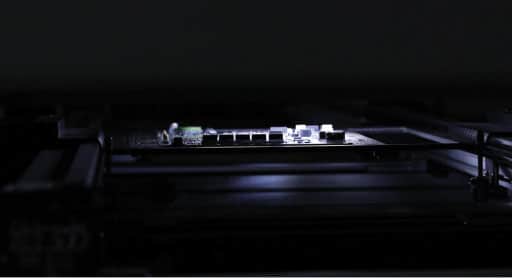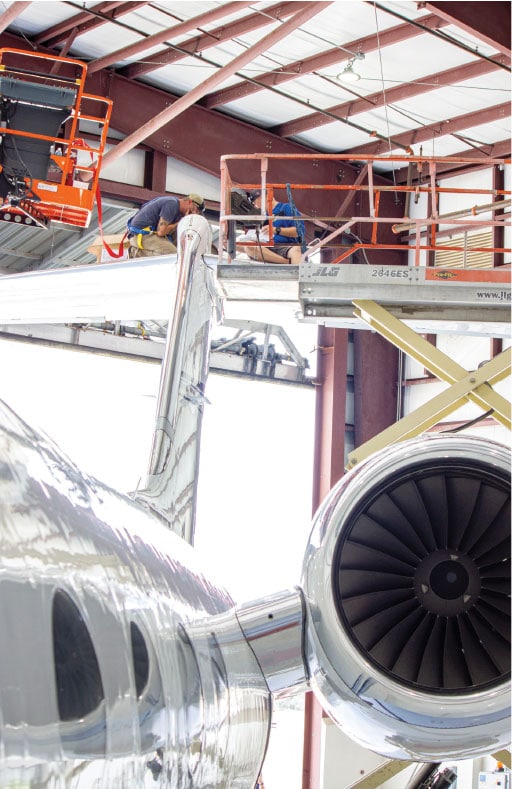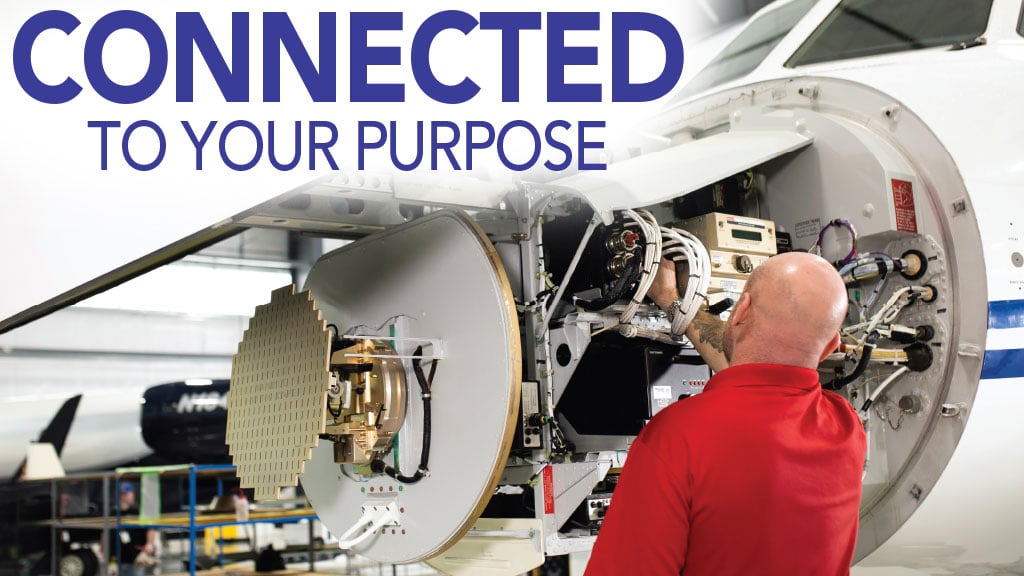The three most important things on the aircraft for the people who sit in the back of a business jet are said to be the crew, the catering … and the connectivity.
In the COVID-19 era, one thing has become clear: the need for inflight connectivity is more important than ever before. Many business executives today are using their ‘office in the sky’ as a critical asset to manage the demands on their professional and personal lives while adhering to safety and social distancing requirements.
They are using the technology on board the aircraft to conduct virtual meetings during flights, manage their inbox, lead remote workforces, conduct video conference calls, and stay on top of breaking news. Many are also holding in-person meetings on board the aircraft while on the tarmac instead of driving to an office to help ensure personal health and safety.

All that combined highlights the increased importance connectivity plays for today’s business traveller who requires their connectivity provider to deliver ever greater bandwidth with faster speeds and more personal services.
Fewer Flights but Usage is Up
Dave Mellin is the director of communications for Gogo Business Aviation which has been at the forefront of the internet-on-aircraft phenomenon offering both Air to Ground (ATG) and satellite connectivity on the back of its cell tower backbone notes an important aspect: although business aviation traffic is still not at pre-pandemic levels, his business is seeing a double-digit increase in data consumption since the COVID pandemic hit.
“So even though flights are down, data usage is up — it’s a statement about how important connectivity has become,” says Mellin. “It’s one of the big reasons we just announced a new unlimited data and streaming plan — unique in business aviation because it comes with no caveats. For Gogo, data is data.”
Insatiable Demand
Chris Moore is president at Satcom Direct Business Aviation which provides onboard connectivity in addition to a complete flight system via its partnership with satellite partners including Inmarsat supporting JetConnex and SwiftBroadband services and IntelSat which operates the FlexExec Ku-band satellite network for which SD holds Master Distributorship status. He agrees with the near insatiable demand for high-speed connectivity.
“Connectivity and high-speed data have become leading priorities for owners and operators and the connectivity stakeholders are responding by significantly investing in more powerful, more accessible high-speed data for business jets,” he says. “Every year we are moving closer towards emulating on the ground functionality in the air, and that is what customers want and expect. All stakeholders in the supply chain are investing heavily to improve infrastructure, hardware, software, and flexibility of service.”
Moore notes that existing satellite constellations are being updated with the number of LEO, MEO and GEO services growing. This all combines to help deliver more bandwidth for more aircraft. Indeed, the costs associated with outfitting aircraft for high-speed data are gradually reducing as more competition enters the market, with the size of the equipment also reducing.

Meanwhile, Honeywell’s JetWave system connects to the Inmarsat Jet ConneX Ka-band satellite system through either a tail-mounted antenna on mid-size jets or with a fuselage-mounted antenna for large-size jets. John Peterson, vice president and general manager of Honeywell’s software and services business, reports that the business has witnessed a slowdown in the cabin connectivity and wifi installation in the business aviation market. Even so, there has remained a steady demand in the aftermarket as owners now judge connectivity capability an essential feature of the business aviation proposition. He says the fun social media channels of old have now developed dramatically to become important real-time business networking tools, constantly keeping executive teams informed and effectively managed. “When you consider a HNWI corporate executive is costing the business $10,000 an hour and the aircraft $100,000 an hour,” Peterson says, “the pressure on these executives to keep turning the data in order to keep people and businesses profitable is immense.”
He says the goal of businesses like Honeywell is to help operators keep the balance between cost, speed and the region so an aircraft owner/operator needs to decide to opt for satellite-only or have an additional air to ground ATG component. “These are all things that need to be sorted out, to balance all these scenarios and the algorithm becomes even more complex when you start to trade off within those technologies. It becomes a sophisticated choice for operators to get that balance right. Many are taking advantage of the aircraft being on the ground to book in their installation slots as they understand that the aircraft will only depreciate in value if their second-hand aircraft fails to upgrade,” says Peterson.

Taking Advantage of the Pandemic
Owners have indeed been taking advantage of the pandemic slowdown. As an aircraft repair station, Flying Colours is deemed an essential service by the authorities in the USA and Canada. This has enabled the business to continue operations throughout the pandemic and to support its customers around the world. Kevin Kliethermes, director of sales at Flying Colours, reports that although some customers have delayed work as those owning aircraft in Europe have been restricted on flying due to the changing travel restrictions, other customers have moved their maintenance schedules forward as regular flying was restricted so they used downtime to undertake maintenance work. “This work regularly includes satcom/connectivity upgrades as we always advise our customers to install systems that will remain current for years to come,” he says.
Connectivity providers have certainly not stopped innovating during the pandemic and are all planning to meet significant anticipated demand. James Person, Viasat’s head of sales and business development in its business and VVIP aviation division reports that just as the demand on the ground continues to increase for higher speeds, usually driven by higher resolution video formats such as 4K and 8K, his business expects that trend for internet data speed requirements to prevail for the foreseeable future.
What is Viasat doing from a technology perspective to prepare for the growing demand for higher speeds? One major area of focus is its advanced satellite technology. With each generation of Viasat satellites, it adds typically an order of magnitude – that is, at least 10x – the amount of capacity per satellite.
“As an example,” Person says, “our first-generation Ka-band satellites that Viasat operates, such as WildBlue-1, have in the order of 10 Gbps (gigabit per second) of total throughput capacity. Our European Ka-band satellite, KA-SAT, has nearly 100 Gbps. ViaSat-2, which launched in 2017 has over 250 Gbps, and each ViaSat-3 satellite, which start launching in 2022, have over 1000 Gbps or a terabit per second each of capacity. And because it’s a Viasat designed shipset, it makes its hardware forward-compatible, so a Viasat Ka-band shipset installed today will be able to take advantage of advances in its ViaSat-3 constellation when it begins launching next year.
This incredible increase in satellite capacity – and in the smarts of the satellite to adjust that capacity to when and where it is needed – will be critical to keep up with that never-ending demand for higher speeds.
Satcom Direct’s Chris Moore believes that as the digitization of business aviation continues, his business will focus on designing and delivering satellite connectivity services built specifically for the needs of the business aviation sector.
“Our SD Plane Simple antenna systems are leading the charge in terms of providing more high-speed data to more aircraft around the world at more affordable rates,” he says. The Plane Simple antenna system series is the first network-integrated terminal designed exclusively for business aviation and aims to bring reliable connectivity to a much broader range of aircraft than ever before. Moore says the simple 2LRU system (the antenna and a single modem) simplifies retrofit installation and so reduces costs, reduces footprint, and provides a seamless transition path to future technology through its agnostic design to keep up with future technology.
He adds that this simplified system results in more reliable faster connectivity, in smaller formats, at competitive price points, all of which is attractive to existing and new customers. Low-cost installation reduces the burden of adding high-speed connectivity and the modular design enables minimally invasive upgrades. The system can also be located in the unpressurised area of the fuselage so freeing up valuable baggage compartment space.
The first Plane Simple Ku-band tail mounted antenna will support Intelsat’s Ku-band FlexExec satellite service and is anticipated to enter into service this year and will launch with flexible service plans aimed to align with how flight departments manage budgets.
As part of the SD eco-system of hardware, software, ground infrastructure and customer support, Moore says the addition of the Plane Simple antennas positions SD as a single source for all business aviation connectivity needs which streamlines the ownership and aircraft maintenance/management experience. “We are excited about the possibilities this brings for owners and operators seeking reliable, cost effective and easy to install high speed data systems,” he says, adding that a second Ka-band tail mounted antenna variant will come to market towards the end of 2022.
On Track for 5G
Gogo’s Dave Mellin meanwhile says his business believes the future of hi speed data is 5G — at least for the foreseeable future. “That’s why we’re building Gogo 5G. Data consumption has increased by 38% year over year on the ground, and the same applies to inflight connectivity, so the need for faster speeds and vastly increased capacity will be necessary, and Gogo 5G will be able to accommodate that increased demand long term.”
He says the business will launch Gogo 5G in 2022 and that the business remains on track for that. “We’ve crossed some significant milestones with testing the 5G belly mounted antennas and we’ve completed our first end-to-end call using the Gogo 5G SIM card so we are feeling optimistic about the progress we’re making. There is a worldwide semiconductor chip shortage, and that has impacted our 5G plans, but that is out of our control and everything else that is in our control, we are executing according to plan.”
When launched Gogo’s ATG system only became operational once the aircraft went above 10,000 ft due to an original design decision based on the Federal Aviation Administration ban on using personal electronic devices below that level. Since that regulation was relaxed, Gogo can now connect at 3,000 ft thanks to its AVANCE software. “What is significant about that,” Mellin says, “is that we were able to make that happen with a software push done over the air. No one had to board the aircraft or have any physical interaction on the aircraft. No down time to implement that change — that’s a massive increase in efficiency and saves operators thousands every time we push new software.”
That lower service altitude is significant for business travellers because it can provide up to 20 minutes additional connectivity time during normal flights and it makes connectivity more feasible for smaller aircraft such as turboprops that fly short hops or at low altitudes for most of the flight.
Mellin reports that one of the biggest benefits with the lower service level has been with the turboprops and some of the aircraft that fly in congested airspace. “One of our customers told us that when he flies into Teterboro — the airport just outside New York City — every time they have him drop below 10,000 feet way early, often for periods of 30 minutes or longer before landing, to avoid all the commercial aircraft flying into Newark, JFK or LaGuardia. Whenever that happened, he’d lose connectivity, but now he has that much more time to continue working.”
Future Trends
Viasat’s James Person sees an acceleration of interest and requirements for high-speed connectivity in smaller business and private aircraft. “In the past, perhaps due to limitations on SWaP (size, weight and power) as well as cost of equipment or service, satellite-based high-speed connectivity was an option for large cabin and long-range aircraft only,” he says. “Now with smaller shipsets, such as Viasat’s Ka-band or Ku-band 3-LRU shipsets, super-mid cabin aircraft can now have the same connectivity experience.”
ViaSat is seeing great demand in this category, including among the Embraer Praetor, Bombardier Challenger 300 series, and Gulfstream G280 for the same 20+ Mbps that it had already been delivering to large cabin aircraft. He says COVID flying restrictions served to accelerate this trend as travellers couldn’t fly to other countries/continents and with the increased usage of domestic fractional or charter aircraft usage, demand for internet service aboard increased.
Video Usage Soars
A second trend that continues is the increase in the amount of video that is consumed aboard business and private aircraft. As cellular plans and networks on the ground moved to enable streaming film, sports, and other content, those same mobile users kept their expectations high when going airborne. Again, a COVID trend of video conference calling accelerated this trend of the expectation for video calls while in flight. As a consequence, Viasat lifted the lid on its Ka-band speeds that enabled more users to stream simultaneously on business aircraft and added a new 200 GB monthly plan as well as including its Unlimited Streaming option in its top plans to support this trend of greater video consumption.
Satcom Direct’s Chris Moore commenting on the likely direction that satcoms are headed says the role of connectivity is evolving as it has become more than just a means of staying connected, it has developed into a data management system and he anticipates this will continue to evolve. “Communications is now a given,” he says, “but the optimisation of the data adds value to all parts of the flight operations.” In addition, he notes, the data generated supports capturing a digital history of the aircraft performance from the day the systems are installed. This helps retain asset value through the collection of accurate, validated, real-time data for existing and future owners and helps protect owner investment.
Open Architecture
The SD connectivity eco-system has been developed using open architecture approach which means that customers can plug-in third-party tools that support maintenance tracking, fueling, or flight planning. Data generated by the aircraft platform is shared by the SD eco-system with for example maintenance tracking software or engine manufacturers to support development and pro-actively engage in predictive maintenance management. This all helps reduce the downtime of an aircraft/fleet.
Advancing satcom technology is increasingly being seen as improving the passenger experience, supporting more efficient fleet management, and improving safety which enhances the overall ownership experience. Connectivity is no longer just about communications and transmitting data, it is about collecting aggregating, validating, and delivering data to an extended network of stakeholders via a secure and safe network to improve the aircraft management experience.
Honeywell’s Peterson is in complete agreement: “We at Honeywell constantly feel that pressure to perform and keep everything improving and once the people sitting in the back of the aircraft are satisfied, it then becomes more of a matter of getting the whole aircraft connected. And when we talk about connecting the whole of the aircraft, operators are searching for economies of scale, the exact same sort that scheduled commercial aviation enjoys.
“Honeywell has gone through a whole digitization of the air transport industry and has built a huge ground network with TBs of information being processed every month. We are now bringing that to the business aviation community but to make it work, you have to have a connected aircraft which can communicate key pieces of operational data so that everyone responsible for delivering that aircraft mission is sharing the same information and working in collaboration to provide a seamless service similar to that which supports the commercial air transport.”
“The fact is that in business aviation often, no one is expecting you and there is little infrastructure so Honeywell has created the Forge Community data platform bringing together a whole raft of expert airport related services so support the business aviation owner and operator — it is in this way that business aviation community can start enjoying those economies of scale.”
Peterson adds that Honeywell plans to take this to the next level and will for example be able to support the early arrival from feeding Top of Descent messages with Honeywell acting as the ISP to guarantee high levels of reliability through leveraging its scalable software. “We can stitch together the whole business jet user/operator community,” says Peterson.
The Forge Community will bring supplier services together in one place, allowing the operator to pick and choose. “It is very traditional in its thinking but very advanced in the technology behind it and Honeywell is bringing it all together so operations look seamless, flawless. We also want to bring a lot more scale into it in the future. Our mission is getting the whole aircraft connecting, something that is invisible to the passenger.”
High-Speed for All
Flying Colours’ Kevin Kliethermes also discerns more choice emerging in providers. “For many owners high-speed connectivity is now one of the most important elements of the passenger experience and that demand for more data, more quickly around the globe is something we are finding small to mid-size aircraft owners are also requesting. High speed data was once just a feature available to the large cabin aircraft, not anymore.
“The demand is stimulated by a consistent introduction of more robust systems that are beginning to come to market. Until recently customers could choose from just one or two providers and the size of the aircraft and where it was operating would potentially limit the possibilities, as well as budget costs. Now the situation is changing as high-speed data is being made viable for super and mid-size aircraft. Just recently we installed the Honeywell JetWave Ka-band system onto a Bombardier Challenger 604 which is the first time we have had to fulfill this request. It has always been the preferred choice of the large jets, but we expect to see more requests for high-speed services on these types of aircraft.”
